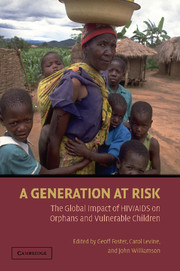Book contents
- Frontmatter
- Contents
- Foreword
- Preface
- Contributors
- Introduction: HIV/AIDS and Its Long-Term Impact on Children
- 1 Family and Community-Based Care for Children Affected by HIV/AIDS: Strengthening the Front Line Response
- 2 Strengthening Households and Communities: The Key to Reducing the Economic Impacts of HIV/AIDS on Children and Families
- 3 The Response of the Educational System to the Needs of Orphans and Children Affected by HIV/AIDS
- 4 Psychosocial Impact of the HIV/AIDS Epidemic on Children and Youth
- 5 Human Rights and Children Affected by HIV/AIDS
- 6 Religion and Responses to Orphans in Africa
- 7 Making the Right Choices in the Asia-Pacific Region: Protecting Children and Young People from HIV and Its Impacts
- 8 Troubled Tapestries: Children, Families, and the HIV/AIDS Epidemic in the United States
- 9 Interventions to Support Children Affected by HIV/AIDS: Priority Areas for Future Research
- 10 Finding a Way Forward: Reducing the Impacts of HIV/AIDS on Vulnerable Children and Families
- Chronology of Important Events
- Resource Guide
- Index
- References
7 - Making the Right Choices in the Asia-Pacific Region: Protecting Children and Young People from HIV and Its Impacts
Published online by Cambridge University Press: 05 June 2012
- Frontmatter
- Contents
- Foreword
- Preface
- Contributors
- Introduction: HIV/AIDS and Its Long-Term Impact on Children
- 1 Family and Community-Based Care for Children Affected by HIV/AIDS: Strengthening the Front Line Response
- 2 Strengthening Households and Communities: The Key to Reducing the Economic Impacts of HIV/AIDS on Children and Families
- 3 The Response of the Educational System to the Needs of Orphans and Children Affected by HIV/AIDS
- 4 Psychosocial Impact of the HIV/AIDS Epidemic on Children and Youth
- 5 Human Rights and Children Affected by HIV/AIDS
- 6 Religion and Responses to Orphans in Africa
- 7 Making the Right Choices in the Asia-Pacific Region: Protecting Children and Young People from HIV and Its Impacts
- 8 Troubled Tapestries: Children, Families, and the HIV/AIDS Epidemic in the United States
- 9 Interventions to Support Children Affected by HIV/AIDS: Priority Areas for Future Research
- 10 Finding a Way Forward: Reducing the Impacts of HIV/AIDS on Vulnerable Children and Families
- Chronology of Important Events
- Resource Guide
- Index
- References
Summary
The situation of orphans and vulnerable children in Asia and the Pacific, in particular children affected by AIDS, has received far less study and attention than has the situation in Africa. HIV/AIDS epidemics in the Asia-Pacific region began much later and have not yet risen to sub-Saharan Africa levels. As a consequence, the overall number of children orphaned by AIDS is much lower, below the threshold of most policymakers' concerns. The current low prevalence, however, also means that the most effective method of reducing the problems of children orphaned and affected by AIDS in the region is primary prevention of HIV infection. If countries respond effectively now, the problems of most children who would be affected by HIV in the absence of strong national responses can be averted. Acting now will also keep the magnitude of the problem small enough that available resources and institutions will be better able to address it.
Even with low prevalence, however, the number of affected children in Asia is substantial, owing to the fact that the region has over half the world's population and almost four times as many children (1.2 billion) as sub-Saharan Africa (350 million) (USAID, UNICEF, and UNAIDS 2004: 9). Almost two million Asian children have already lost at least one parent to AIDS, and many more have been or will be directly affected by the epidemic. Millions more children in the region are rendered vulnerable through poverty, prostitution, child labor, and trafficking.
- Type
- Chapter
- Information
- A Generation at RiskThe Global Impact of HIV/AIDS on Orphans and Vulnerable Children, pp. 181 - 212Publisher: Cambridge University PressPrint publication year: 2005



